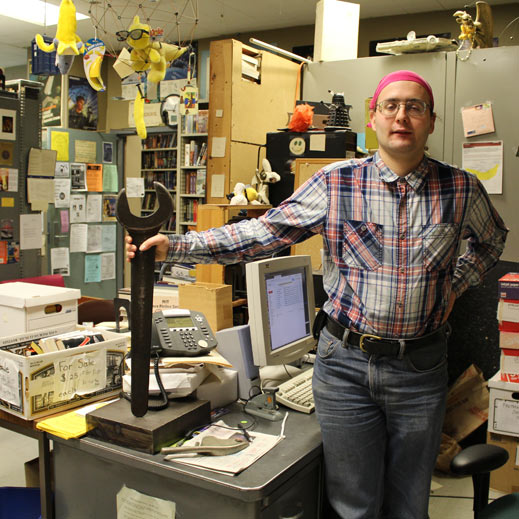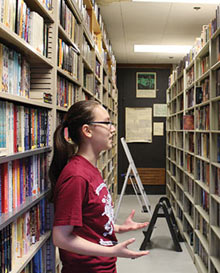60,000 Books and a Few Toy Bananas
Brother Guy Consolmagno ’74, SM ’75, a Jesuit and an astronomer at the Vatican Observatory, was a first-year student at Boston College when he first visited the MIT Science Fiction Society (MITSFS) library. He quickly transferred to MIT.

“Visiting that library for the first time was one of the greatest days of my life,” Consolmagno says. “Science fiction reminds you that science is fun—it’s the best adventure anyone could have. I asked myself, ‘How could I be anywhere else?’”
Located on the fourth floor of the Stratton Student Center, the MITSFS (pronounced mits-fiss) collection is one of the world’s largest public science fiction libraries—home to an estimated 90 percent of all English-language science fiction ever published. More than 45,000 books occupy less than 1,700 square feet of space; another 16,000 books sit in storage at an East Boston warehouse.
“Plus, we have complete runs of almost every science fiction magazine dating back to the 1920s,” says chemistry graduate student D. W. Rowlands, a MITSFS member. “Our library keeps growing. It’s a good problem to have, but it’s exhausting.”
The library’s collection includes mainstream titles like the Lord of the Rings and Star Trek novels, rare works like fanzines (fan-published magazines), and even a small collection of science fiction erotica magazines from the 1950s that are locked away from public view.
Early History
The society dates back to 1949, when Rudolf Preisendorfer ’52 and a group of like-minded students met to read his collection of Astounding Science Fiction magazines and later set out to collect back issues of other periodicals from the genre. A few years later, members began dragging a wooden crate filled with books between dorm rooms and the Spofford Room for meetings. (The crate is still on display at the MITSFS library.)
In the 1960s, the society grew and, under the leadership of a group that included Anthony Lewis ’61, L. Court Skinner ’62, SM ’64, PhD ’65, and Marilyn Wisowaty Niven ’62, eventually became a formal MIT club whose popularity spread beyond campus. Annual picnics were attended by well-known authors of popular science fiction.
“MITSFS was a big part of my undergraduate years—the picnics were huge events,” Skinner says. “Isaac Asimov was a great guy, but Hugo Gernsback was a bit of a curmudgeon.”
Skinner served as society president for three years. Today, the student leader of the MITSFS is known as the skinner, one of many distinctive titles that include lady high embezzler (treasurer) and onseck (honorable secretary).
“I certainly didn’t think that the title would last this long,” Skinner says. “But it’s an honor to have your name continue to be associated with MIT.”
Today’s MITSFS
The current-day MITSFS is open about 40 hours per week and holds weekly meetings, usually on Friday evenings, that members admit usually feature very little business. Each meeting begins with the clanking of a two-foot steel wrench onto a massive slab of titanium, and each member of the society, collectively known as Star Chamber, can vote up to four times (once per limb) on any issues brought to poll.

“There is definitely a social aspect, but we’re really just an awesome science fiction library,” says Alexandra Westbrook ’13. “Even if a book isn’t popular or well known, we have almost everything.”
In addition to a near-overflow of books, the library’s shelves are strewn with bizarre trinkets, including a collection of randomly placed toy bananas that no current member can explain.
“MITSFS has a lot of inside jokes that predate current students and, it seems, most alumni,” Rowlands says. “We definitely have an obsession with bananas, but no one seems to know why.”
Physical size remains MITSFS’s biggest issue—there are no plans expand the library. But the society continues to expand, thanks to active membership, a small endowment, and a boundless supply of both science fiction literature and readers at MIT.
Matching MIT’s Mission
“Science is the heart of science fiction, but the meat of it is engineering,” says Susan Shepherd ’11. “MITSFS keeps growing because of MIT’s central mission—explore science, push boundaries. Someone who wants to change the world—that’s the type of person who loves to read science fiction.”
MITSFS currently has about 300 dues-paying members, and Rowlands estimates that about 60 percent are current MIT students. Annual membership, which is open to the general public, starts at $15, but there are more expensive options, including a $260 lifetime membership and a $2,600 membership that transcends mortality.
“The real purpose of the $2,600 membership was a way for people to give to MITSFS and feel like they were getting something in return,” Rowlands says. “But if you die and come back undead or uploaded, you do have the option to maintain your membership.”
Keep Reading
Most Popular
Large language models can do jaw-dropping things. But nobody knows exactly why.
And that's a problem. Figuring it out is one of the biggest scientific puzzles of our time and a crucial step towards controlling more powerful future models.
How scientists traced a mysterious covid case back to six toilets
When wastewater surveillance turns into a hunt for a single infected individual, the ethics get tricky.
The problem with plug-in hybrids? Their drivers.
Plug-in hybrids are often sold as a transition to EVs, but new data from Europe shows we’re still underestimating the emissions they produce.
Google DeepMind’s new generative model makes Super Mario–like games from scratch
Genie learns how to control games by watching hours and hours of video. It could help train next-gen robots too.
Stay connected
Get the latest updates from
MIT Technology Review
Discover special offers, top stories, upcoming events, and more.